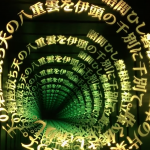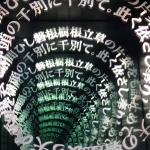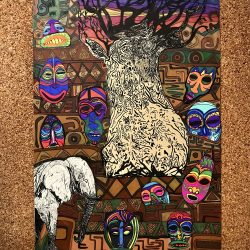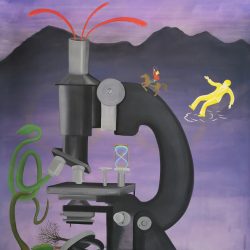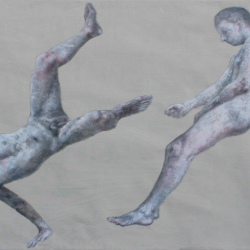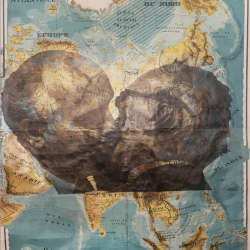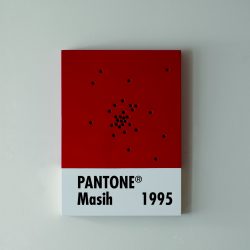work
Shintoism
| category | Illustration |
| subject | Political / Social |
| tags | religion, pray, norito, giappone, japan, giapponese, japanese, specchiinfiniti, infinitymirror, digitalart, artedigitale, app, arteluminosa, lightart, artandscience, arteescienza, science, illusion, scienza, illusione, lightgame, giocodiluci, interaction, shintoism, interazione, harae, shintoismo, kami, preghiera, religione |
| base | 30 cm |
| height | 30 cm |
| depth | 15 cm |
| year | 2019 |
Shintoism is an ancient religion with no founder, doctrines or dogmas. It evolved through a sense of awe and gratitude to natural world and it is expressed trough myth and rituals.
The objects of faith in the Shinto religion are deites called “KAMI”. Whatever seems strikingly impressive posseses the quality of excellence and inspiring a feeling of awe: oceans, mountains, rivers, trees, plants, animals and human beings are all examples of kami. In Shinto all the human beings are regarded as children or descendants of kami. Central to Shinto beliefs is purification known as “HARAE” in Japanese: it is intended to recover both physical and mental purity. Through purification our origin kami nature is restored.
It is important to remember that in Shinto the nature of human beings is considered to be essentially good. It is the practice of personal improvement of correcting one’s path and thus enjoying a positive attitude toward life. Since ancient time Shinto has taugh the goal of human life is to “become a KAMI”, through refining the personality to bring out a clean and bright character. As there is no doctrine of final salvation it is believed that we continue training for purification and further spiritual advancement. After phisical death until one eventually becomes a kami.
In Shinto ceremonies a prayer called Norito is recited in front of the Kami by a chief of presiding shinto priest. Shinto prayers usually open with words in praise of the Kami, make some reference to the origin and possibly the history of the specific ritual, enumerate the offerings presented, express thanksgiving and finally close with some words of respects and awe.
Norito is written and read in archaic Japanese and expressed in the elegant classical language. According to ancient belief, beautiful and correct wording will bring about good. This concept is based on KOTOKAMA, through which they think that words have spiritual power.
For this work part of a Shinto ritual prayer (Norito) has been chosen that says "Word that stops the individual leaves of the Heisei Bone Tree Negishi (Bonsai, ed.) herb. Goodbye to the celestial bait and divide the celestial clouds of the sky in their thousands separately. The heavenly descent is a snake. I am proud of you."
The objects of faith in the Shinto religion are deites called “KAMI”. Whatever seems strikingly impressive posseses the quality of excellence and inspiring a feeling of awe: oceans, mountains, rivers, trees, plants, animals and human beings are all examples of kami. In Shinto all the human beings are regarded as children or descendants of kami. Central to Shinto beliefs is purification known as “HARAE” in Japanese: it is intended to recover both physical and mental purity. Through purification our origin kami nature is restored.
It is important to remember that in Shinto the nature of human beings is considered to be essentially good. It is the practice of personal improvement of correcting one’s path and thus enjoying a positive attitude toward life. Since ancient time Shinto has taugh the goal of human life is to “become a KAMI”, through refining the personality to bring out a clean and bright character. As there is no doctrine of final salvation it is believed that we continue training for purification and further spiritual advancement. After phisical death until one eventually becomes a kami.
In Shinto ceremonies a prayer called Norito is recited in front of the Kami by a chief of presiding shinto priest. Shinto prayers usually open with words in praise of the Kami, make some reference to the origin and possibly the history of the specific ritual, enumerate the offerings presented, express thanksgiving and finally close with some words of respects and awe.
Norito is written and read in archaic Japanese and expressed in the elegant classical language. According to ancient belief, beautiful and correct wording will bring about good. This concept is based on KOTOKAMA, through which they think that words have spiritual power.
For this work part of a Shinto ritual prayer (Norito) has been chosen that says "Word that stops the individual leaves of the Heisei Bone Tree Negishi (Bonsai, ed.) herb. Goodbye to the celestial bait and divide the celestial clouds of the sky in their thousands separately. The heavenly descent is a snake. I am proud of you."




